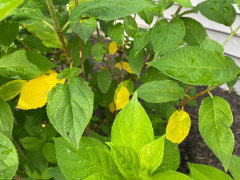The 3-Minute Rule for Hydrangea Leaves Turning Yellow
Wiki Article
Hydrangea Leaves Turning Yellow Can Be Fun For Anyone
Table of ContentsThe Buzz on Hydrangea Leaves Turning YellowThe Buzz on Hydrangea Leaves Turning YellowFascination About Hydrangea Leaves Turning YellowThe 6-Second Trick For Hydrangea Leaves Turning Yellow
Hydrangea plants are understood for their gorgeous blossoms, but occasionally their leaves can transform yellow. This is typically an indicator that something is wrong and the plant requires your help.Nonetheless, Hydrangea leaves turning yellow can be a reason for problem. There are a number of reasons that Hydrangea leaves turn yellow, and most of them are very easy to repair. Allow's look at one of the most common reasons Hydrangea leaves turn yellow and just how to fix them. Hydrangea leaves usually transform yellow when the plant is overwatered.
When the origins of a plant are immersed in water for extended periods, they begin to stifle and rot. This procedure cuts off the origins' oxygen supply, causing the fallen leaves to transform yellow and eventually die. Overwatering can likewise bring about various other troubles such as fallen leave drop, origin damages, and fungal growth.
If you think your Hydrangea is overwatered, the most effective service is to allow the soil completely dry out completely prior to watering once again. It's also a great concept to inspect the drainage of your pot or garden bed and make sure that water is not pooling around the plant's origins. Hydrangea plants need well-drained soil to grow.
The Best Strategy To Use For Hydrangea Leaves Turning Yellow
Hydrangea leaves can also transform yellow if the plant is not getting adequate water. This takes place when the plant does not get sufficient water, and the soil starts to dry out.
This is known as "plant food melt," It happens when the plant's roots are revealed to way too much fertilizer. The roots can not take in all of the nutrients and come to be damaged. This damage creates the leaves to turn yellow and ultimately die. Various other indications of fertilizer melt include brownish or yellow leaves, wilting, and stunted development.
This will certainly help eliminate any excess fertilizer from the roots of the plant. It's likewise a great idea to decrease the quantity of plant food you are using.
Things about Hydrangea Leaves Turning Yellow

If your Hydrangea is ravaged with insects, treating the plant with neem or gardening oil is the best service. It's additionally excellent to remove any kind of afflicted fallen leaves from the plant (Hydrangea Leaves Turning Yellow).
Hydrangea leaves can additionally transform yellow if the temperature stresses the plant. The fallen leaves of the plant will certainly transform yellow and begin to go down off.
If the temperature see it here stresses your Hydrangea, you need to relocate the plant to a place where it will certainly be secured from the extreme chilly or warm. You can also attempt to offer the plant with some partial shade if exposed to direct sunlight. You can additionally attempt including compost around the plant base to help regulate the temperature.
Some Known Details About Hydrangea Leaves Turning Yellow
The fallen leaves can additionally transform yellow if the Hydrangea plant has origin rot. This is typically created by overwatering or bad water drainage. find more When the plant's roots are immersed in water for as well long, they start to rot. Among the most typical origin rot signs and symptoms is yellowing leaves, as the fungus stops the origins from absorbing nutrients from the soil.Other indications of root rot consist of stunted development, wilting, and fallen leave decline. Check the roots of your Hydrangea if it has origin rot. If they are black or brown, after that they are possibly rotten. If some healthy and balanced roots are left, you can attempt to save the plant by replanting it in a new pot with fresh soil.
Water the plant very carefully, seeing to it not to overwater it. If your Hydrangea is greatly impacted by root rot, starting with a new plant is best. Natural causes can additionally create yellow hydrangea leaves. One of the most usual reason is the plant's age. As Hydrangeas age, their fallen leaves will slowly transform yellow and brown prior to dropping off the plant.
You can help the plant by guaranteeing it is obtaining sufficient water and nutrients. You can also mulch around the plant base to help it retain dampness. There are numerous reasons hydrangea leaves might transform yellow and diminish. Hydrangea Leaves Turning Yellow. One look here possibility is that the plant is not getting adequate water.
Report this wiki page